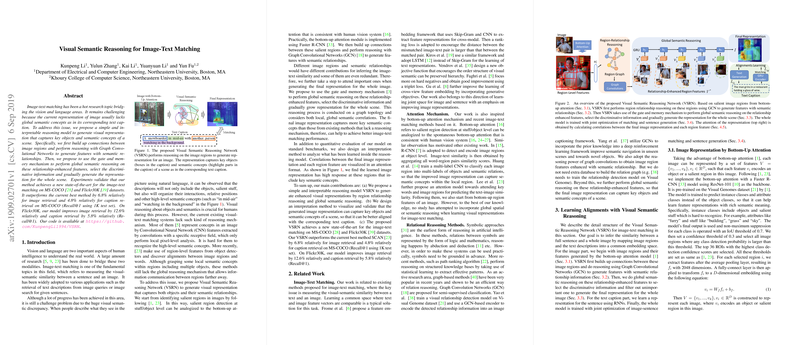Visual Semantic Reasoning for Image-Text Matching: A Detailed Overview
The paper "Visual Semantic Reasoning for Image-Text Matching" introduces a model, Visual Semantic Reasoning Network (VSRN), that significantly enhances the task of relating images to their textual descriptions. The research seeks to address the challenge of image-text matching, where existing systems often fall short due to their inability to bridge the semantic gap between the modalities effectively. Traditional approaches primarily rely on region-level features and local analysis, with insufficient reasoning to capture the comprehensive semantic meaning that textual descriptions often convey.
The proposed VSRN strives to overcome these limitations by integrating a reasoning mechanism designed to generate a holistic visual representation. This representation encapsulates key objects and semantic concepts within a scene, aligning more closely with the corresponding text. The model operates in two primary stages: region relationship reasoning and global semantic reasoning.
Initially, VSRN employs a Graph Convolutional Network (GCN) to analyze and reason the relationships between detected image regions. By constructing a fully-connected graph, the model encodes the semantic relationships between these regions, thus enhancing region features with contextual insight. Subsequently, the enhanced features undergo a global semantic reasoning phase which utilizes gate and memory mechanisms to distill relevant information, ultimately crafting a unified representation of the image.
The efficacy of VSRN is validated through extensive experimentation on MS-COCO and Flickr30K datasets. The model achieves state-of-the-art performance, surpassing prevalent methods in both image and caption retrieval tasks. Notably, on the MS-COCO dataset, VSRN demonstrates a relative improvement of 6.8% in image retrieval and 4.8% in caption retrieval on the 1K test set compared to prior methods. On the Flickr30K dataset, it exhibits an even more pronounced enhancement, with a 12.6% rise in image retrieval accuracy.
VSRN's success stems from its innovative approach to semantic reasoning. By integrating relationship reasoning and subsequent global reasoning within its architecture, the model effectively captures and synthesizes high-level semantic insights, often overlooked in previous approaches. The authors further complement their quantitative assessment with an interpretative method, visualizing how image representations capture semantic concepts.
The implications of this research extend to multiple domains where precise image-text association is critical, such as digital content retrieval and automated descriptive frameworks in multimedia applications. The method's interpretability also holds promise for enhancing transparency and explainability in AI systems interacting with multimodal data.
Future developments could explore scaling the VSRN architecture to accommodate broader datasets, further refining its semantic reasoning capabilities. Additionally, evaluating its integration into more complex downstream tasks could substantiate its utility in diverse real-world applications. Overall, the presented model contributes a significant advancement in visual-semantic reasoning, paving avenues for subsequent breakthroughs in image-text matching and beyond.
